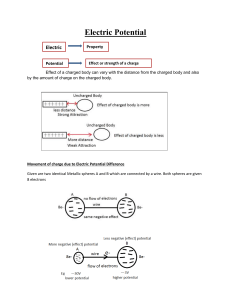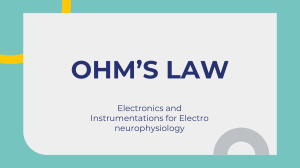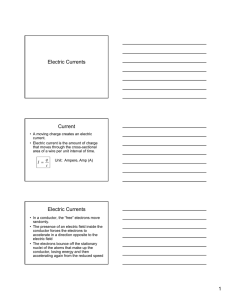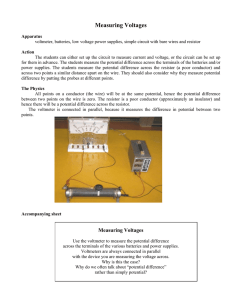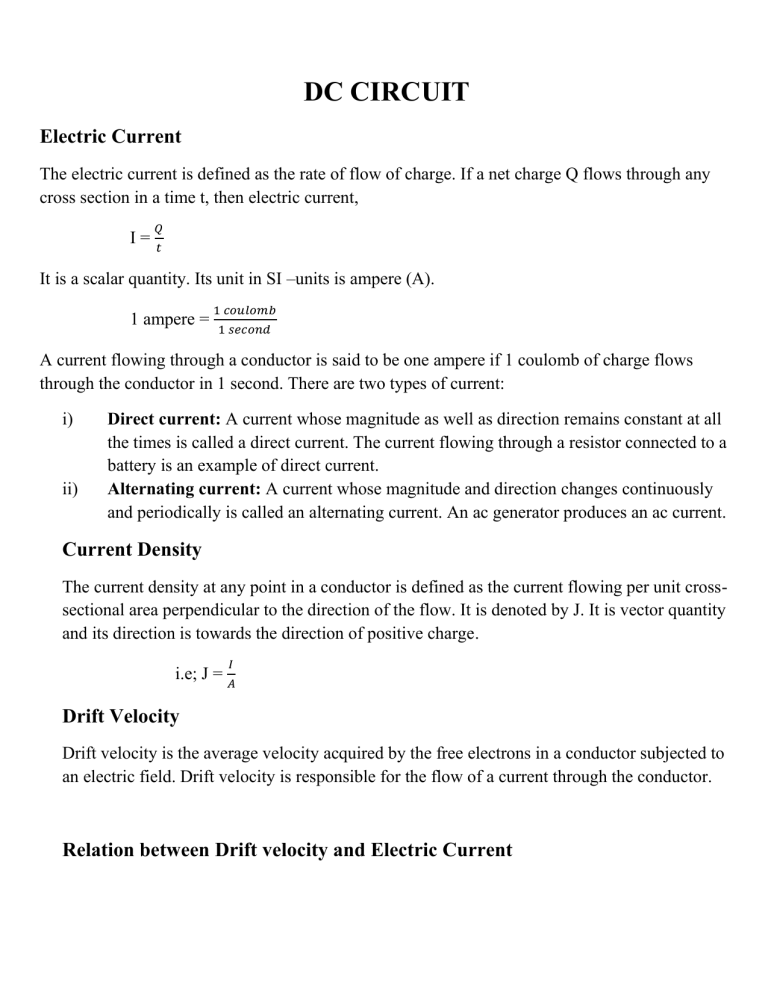
DC CIRCUIT Electric Current The electric current is defined as the rate of flow of charge. If a net charge Q flows through any cross section in a time t, then electric current, I= 𝑄 𝑡 It is a scalar quantity. Its unit in SI –units is ampere (A). 1 ampere = 1 𝑐𝑜𝑢𝑙𝑜𝑚𝑏 1 𝑠𝑒𝑐𝑜𝑛𝑑 A current flowing through a conductor is said to be one ampere if 1 coulomb of charge flows through the conductor in 1 second. There are two types of current: i) ii) Direct current: A current whose magnitude as well as direction remains constant at all the times is called a direct current. The current flowing through a resistor connected to a battery is an example of direct current. Alternating current: A current whose magnitude and direction changes continuously and periodically is called an alternating current. An ac generator produces an ac current. Current Density The current density at any point in a conductor is defined as the current flowing per unit crosssectional area perpendicular to the direction of the flow. It is denoted by J. It is vector quantity and its direction is towards the direction of positive charge. i.e; J = 𝐼 𝐴 Drift Velocity Drift velocity is the average velocity acquired by the free electrons in a conductor subjected to an electric field. Drift velocity is responsible for the flow of a current through the conductor. Relation between Drift velocity and Electric Current Consider a conductor having length l, cross sectional area A, n be the number of free electrons per unit volume in it, e be the charge of each electron having the drift velocity v d. Then, Volume of the conductor = Al Total number of free electrons in this volume = nAl Total charge in this volume(Q) = neAl Now the current I through the conductor is given by, I= 𝑄 𝑡 = neA 𝑙 𝑡 I = neAvd 𝑙 Where, = vd is the drift velocity of electron. 𝑡 From above expression the value of drift velocity can also be obtained as, Vd = 𝐼 𝑛𝑒𝐴 And current density is, J= 𝐼 𝐴 J = nevd Ohm’s Law Ohm’s law states that the current flowing through a conductor is directly proportional to the potential difference across its ends, provided that the physical conditions (temperature, mechanical strain etc) of the conductor remain the same. i.e; V α I V = IR Where, R is the constant of proportionality known as resistance of the conductor. Experimental Verification of Ohm’s law Ohm’s law can be verified by using a simple circuit as shown in fig above. A resistor R is connected in series with a battery, an ammeter and a rheostat through one-way key K in the circuit. A voltmeter V is connected across R to measures the potential difference across it. The ammeter and voltmeter readings are noted by adjusting rheostat at different positions. When a graph is plotted between I and V, a straight line is obtained which passes through the origin as shown in fig above. This shows that I α V which is ohm’s law. Resistance The resistance of a conductor is defined as its ability to oppose the flow of charge through it. It’s SI units is ohm (ῼ). i.e; R = 𝑽 𝑰 The resistance of a conductor is said to be one ohm if one ampere current flows through it under a potential difference of one volt. Temperature coefficient of resistance of a conductor is the increase in resistance per unit original resistance per 0C rise in temperature. So, α= ∆𝑅 𝑅1 𝛥𝜃 Metals have positive temperature coefficient of resistance. This means that resistance increases with rise in temperature. Resistivity It is observed that resistance of the conductor is, R α l and R α 1 𝐴 Combining above two we get, R= 𝜌𝑙 𝐴 Where, 𝜌 is a proportionality constant known as resistivity or specific resistance of the material of conductor. Thus, the resistivity of the material of a conductor is defined as the resistance of the conductor of unit cross-sectional area per unit length. It s unit is ohm meter (ῼ m) in SI units. Conductivity The reciprocal of resistivity of a conductor is called its conductivity. It is denoted by the symbol 𝜎. Its unit is ῼ-1m-1 . i.e; 𝜎 = 1 𝜌 The relation between current density and electric field intensity is, J = 𝜎E Ohmic and Non-Ohmic Conductors The conductors which follow ohm’s law i.e; I α V are called ohmic conductors. Most of the metals such as copper, silver, gold are ohmic conductors. The conductors which do not follow ohm’s law i.e; I α V are called non-ohmic conductors. Electrolytes, vacuum tubes, junction diodes, transistors etc are the examples of non-ohmic conductors. Resistances in series and parallel In electric circuits, the resistances can be connected in two different ways: i. ii. Series combination Parallel combination Series combination of Resistances Resistances are said to be connected in series when they are joined end-to-end, so that same current flows through each of them. Let I be the current flowing through each resistors R1, R2, R3 and V1, V2 and V3 be the potential difference across R1, R2 and R3 respectively. Now from ohm’s law we have, V1 = IR1 , V2 = IR2 and V3 = IR3 If V be the total potential difference across the whole combination, then V = V1 + V2 + V3 V = IR1 + IR2 + IR3 𝑉 𝐼 = R1 + R2 +R3 𝑹eqv = R1 + R2 +R3 Thus, when resistors are connected in series its equivalent or net resistance increases than the individual resistnaces. Parallel combination of resistances Resistances are said to be connected in parallel if one end of each resistor is connected to a common point and the other ends to another common point so that the potential difference across each resistor is the same. Let I1 ,I2 and I3 be the current flowing through each resistors R1, R2, R3 and V be the common potential difference across R1, R2 and R3 respectively. Now from ohm’s law we have, I1 = 𝑉 𝑉 , I2 = 𝑅1 𝑅2 and I3 = 𝑉 𝑅3 If I be the total amount of current flowing across the whole combination, then I = I1 + I2 + I3 I= 𝐼 𝑉 𝑉 𝑅1 = 𝟏 𝑹𝒆𝒒𝒗 + 1 𝑅1 = 𝑉 𝑅2 + + 1 𝑅2 𝟏 𝑹𝟏 + 𝑉 𝑅3 + 1 𝑅3 𝟏 𝑹𝟐 + 𝟏 𝑹𝟑 Thus, when resistors are connected in parallel its equivalent or net resistance decreases than the individual resistances. Q1) A potential difference of 4.5 V is applied between the ends of wire that is 2.5 m long and has radius of 0.654 mm. The resulting current through the wire is 17.6 A. what is the resistivity of the wire? (ans: 1.37 x 10-7 ῼ m) Q2) A 199 cm long wire has resistance of 3.5ῼ. Calculate its diameter. (resistivity of material of the wire is 6.4 x 10-7 ῼ m) Numericals: 1) Two resistors of resistance 1000ῼ and 2000ῼ are joined in series with a 100V supply. A voltmeter of internal resistance 4000ῼ is connected to measure the potential difference across 1000ῼ resistor. Calculate the reading shown by the voltmeter. Soln: 2) Two lamps rated 25W-220V and 100W-220 V are connected to 220V supply. Calculate the powers consumed by the lamps. Soln: 3) Two resistance of 1000ῼ and 2000ῼ are placed in series with 50V mains supply. What will be the reading on a voltmeter of internal resistance 2000ῼ when placed across the 1000ῼ resistor? What fractional change in voltage occurs when voltmeter is connected? Soln: 4) A cell of emf 18V has an internal resistance of 3ῼ. The terminal p.d. of the battery becomes 15V when connected by a wire. Find the resistance of the wire. Soln: 5) In the given figure, the current through the 3ῼ resistor is 0.8A. Find the potential drop across 4ῼ resistor. Soln: 6) A battery of emf 1.5V has a terminal p.d of 1.25V when a resistor of 25ῼ is joined to it. Calculate the current flowing, the internal resistance and terminal p.d. when a resistance of 10ῼ replaces 25ῼ resistor. Soln : 7) In the given figure, when switch s is open, the voltmeter V reads 3.08V. when the switch is closed, the voltmeter reading drops to 2.97V and the ammeter A reads 1.65A. Find the emf, the internal resistance of the battery and the resistor R. Assume that the two meters are ideal. Soln: Given, Emf (E) = 3.08V Voltange (V) = 2.97V Current (I) = 1.65A Internal resistance(r) = ? External resistance(R) = ? We have, E = V+Ir 3.08 = 2.97 + 1.65r r = 0.067ῼ Again, V =IR 𝑉 2.97 Or, R = 𝐼 = 1.65 = 1.8ῼ 8) The resistance of a conductor is 10ῼ at 500C and 15ῼ at 1000C. Calculate its resistance at 00C. Soln:

